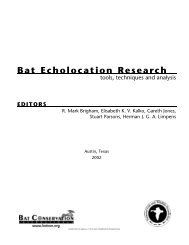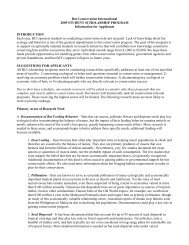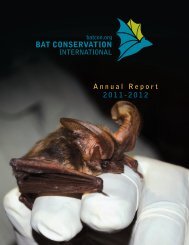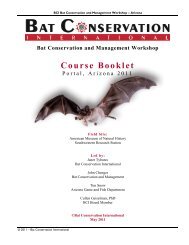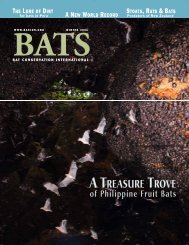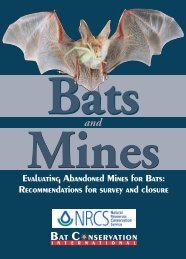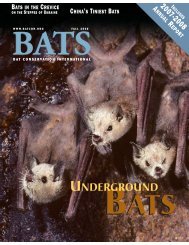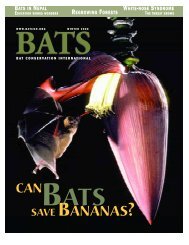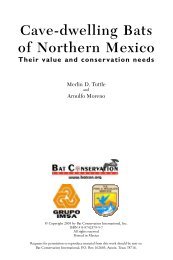Forest Management & Bats - Bat Conservation International
Forest Management & Bats - Bat Conservation International
Forest Management & Bats - Bat Conservation International
You also want an ePaper? Increase the reach of your titles
YUMPU automatically turns print PDFs into web optimized ePapers that Google loves.
BAT BA S I C S<br />
More than 1,100 species of bats account for almost a quarter<br />
of all mammal species.<br />
<strong><strong>Bat</strong>s</strong> are exceptionally vulnerable to extinction, in part<br />
because they are the slowest-reproducing mammals on Earth<br />
for their size, most producing only one young annually.<br />
Contrary to popular misconceptions, bats are not blind, do<br />
not become entangled in human hair and seldom transmit<br />
disease to other animals or humans.<br />
<strong><strong>Bat</strong>s</strong> are the only mammals capable of true flight. Most bat<br />
species use an extremely sophisticated biological sonar called<br />
echolocation to navigate and hunt for food. Some bats can<br />
detect an object as fine as a human hair in total darkness.<br />
Worldwide, bats are primary predators of night-flying<br />
insects. A single little brown myotis, a common resident of<br />
North American forests, can consume 1,000 mosquito-sized<br />
insects in just one hour.<br />
All but four of the 47 species found in the United States and<br />
Canada feed solely on insects, including many destructive<br />
agricultural pests. The remaining species feed on nectar,<br />
pollen and the fruit of cacti and agaves and play an important<br />
role in pollination and seed dispersal in southwestern<br />
deserts.<br />
The 20 million Mexican free-tailed bats at Bracken Cave,<br />
Texas, eat approximately 200 tons of insects nightly.<br />
A colony of 150 big brown bats, which often roost in tree<br />
cavities, can eat enough cucumber beetles each summer to<br />
eliminate up to 33 million of their rootworm larvae, a major<br />
agricultural pest.<br />
Desert ecosystems rely on nectar-feeding bats as primary<br />
pollinators of giant cacti, including the famous organ pipe<br />
and saguaro of Arizona.<br />
<strong>Bat</strong> droppings in caves support whole ecosystems of unique organisms, including bacteria useful in detoxifying wastes,<br />
improving detergents and producing gasohol and antibiotics.<br />
More than half of American bat species are in decline or already listed as endangered. Losses are occurring at alarming<br />
rates worldwide.<br />
During cold weather, many bats hibernate in caves, mines or other sites that provide stable, cool temperatures. Others<br />
migrate to warmer climates, sometimes traveling up to a thousand miles or more.<br />
For their size, bats are among the world’s longest-lived mammals. The little brown myotis, a common forest bat, has a<br />
documented life span of up to 34 years in the wild.




